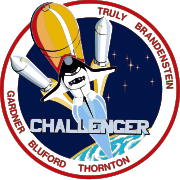
Back STS-8 Arabic STS-8 Bulgarian STS-8 Catalan STS-8 Czech STS-8 Danish STS-8 German STS-8 Spanish STS-8 Estonian استیاس-۸ Persian STS-8 Finnish
 INSAT-1B is deployed from Space Shuttle Challenger | |
| Names | Space Transportation System-8 |
|---|---|
| Mission type | Communications satellite deployment |
| Operator | NASA |
| COSPAR ID | 1983-089A |
| SATCAT no. | 14312 |
| Mission duration | 6 days, 1 hour, 8 minutes, 43 seconds (achieved) |
| Distance travelled | 4,046,660 km (2,514,480 mi) |
| Orbits completed | 98 |
| Spacecraft properties | |
| Spacecraft | Space Shuttle Challenger |
| Launch mass | 110,108 kg (242,747 lb) |
| Landing mass | 92,508 kg (203,945 lb) |
| Payload mass | 12,011 kg (26,480 lb) |
| Crew | |
| Crew size | 5 |
| Members | |
| Start of mission | |
| Launch date | August 30, 1983, 06:32:00 UTC |
| Rocket | Space Shuttle Challenger |
| Launch site | Kennedy Space Center, LC-39A |
| Contractor | Rockwell International |
| End of mission | |
| Landing date | September 5, 1983, 07:40:43 UTC |
| Landing site | Edwards Air Force Base, Runway 22 |
| Orbital parameters | |
| Reference system | Geocentric orbit |
| Regime | Low Earth orbit |
| Perigee altitude | 348 km (216 mi) |
| Apogee altitude | 356 km (221 mi) |
| Inclination | 28.51° |
| Period | 90.60 minutes |
| Instruments | |
| |
 STS-8 mission patch  Seated: Daniel Brandenstein, Pilot, Richard Truly, Commander, and Guion Bluford, Mission Specialist. Standing: Dale Gardner, Mission Specialist, and William E. Thornton, Mission Specialist. | |
STS-8 was the eighth NASA Space Shuttle mission and the third flight of the Space Shuttle Challenger. It launched on August 30, 1983, and landed on September 5, 1983, conducting the first night launch and night landing of the Space Shuttle program. It also carried the first African-American astronaut, Guion Bluford. The mission successfully achieved all of its planned research objectives, but was marred by the subsequent discovery that a solid-fuel rocket booster had almost malfunctioned catastrophically during the launch.
The mission's primary payload was INSAT-1B, an Indian communications and weather observation satellite, which was released by the orbiter and boosted into a geostationary orbit. The secondary payload, replacing a delayed NASA communications satellite, was a four-metric-ton dummy payload, intended to test the use of the shuttle's Canadarm (remote manipulator system). Scientific experiments carried on board Challenger included the environmental testing of new hardware and materials designed for future spacecraft, the study of biological materials in electric fields under microgravity, and research into space adaptation syndrome (also known as "space sickness"). The flight furthermore served as shakedown testing for the previously launched TDRS-1 satellite, which would be required to support the subsequent STS-9 mission.
© MMXXIII Rich X Search. We shall prevail. All rights reserved. Rich X Search